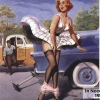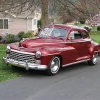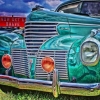
squirebill
Members-
Posts
394 -
Joined
-
Last visited
-
Days Won
1
squirebill last won the day on April 9 2024
squirebill had the most liked content!
Reputation
97 ExcellentProfile Information
-
Gender
Male
-
Location
newtown square,pa
-
Interests
The B1B, hobby in light blacksmithing, 1949 Plymouth Suburban
-
My Project Cars
1948/49 Dodge B1B; 1949 Plymouth Wagon
Contact Methods
-
Biography
B1B Daily driver in the 70's
-
Occupation
Retired
Converted
-
Location
Southeast Pennsylvania
-
Interests
B1B, P18
Recent Profile Visitors
2,914 profile views
-
Could the top of the transmission be hitting the bottom of the transmission tunnel? Just thinking that replacing the rear motor mounts raised the rear of the engine. Now the transmission has to be closer to the bottom of the transmission tunnel especially if the body mounts are squished and need to be replaced. On my '49 the floor panel runs from the left frame to the side of the trans tunnel. Just a thought. Regards.
-
PILOT BUSHING QUANDRY?!?! So it seems an "oilite" sintered bronze bushing has been specified for our mopar flat head engines. Also, the oilite bushing should be handled in such a way that no damage happens to the pores of the sintered bronze. The link offered by sniper even states that the bushing should be installed with constant pressure and not by hammer impacts. So now I go to my service manual that states the bushing should be installed using mopar special tool DD-286 and driven into place with a soft hammer ( impacted into the bore, a no-no). Then the tool is used to "burnish" the bushing to the correct size. Burnishing is somewhat of a polishing process that would affect the pores of the bushing (another no-no). In Figure 19 of the Clutch Section of my service manual, that is titled "Lubricating Pilot Bushing" it says , "Insert about 1/2 teaspoonful Short Fiber Grease in the pilot bushing." (according to Oilite, another no-no, or at least not necessary). Seems to me the oilite bushing was specified but the mopar engineers knew they were going to damage the pores of the sintered bronze by burnishing the bushing to size and therefore lubrication was necessary. I have and will follow the directions in the Service Manual. Just my 2/100 of a dollar.
-
As Hickory mentioned about "rolling in" the upper mains, the service manual I have that covers from 1946 to 54 shows a special tool on Figure 16 in the Engine Section. I never used one because I dropped the crankshaft for a regrind. But instead of the special tool I figure I could fashion one from a cotter pin or nail or something.
-
Again, its been a while....say your working on #1 piston....rotate crank so #1 piston is at bottom of stroke. Remove lower bearing cap, protect cap bolt threads, push piston up off the crank, that should give you room to get the upper bearing shell off the crank or out of the bottom end of the piston rod. Note that when #1 piston is at the bottom of stroke so will be #6 so do #6 next. Then rotate crank 120 degrees and do #2 and #5, rotate crank another 120 degrees and do #3 and #4.
-
Been awhile since I've been in an engine but I would recommend that once you remove the lower cap place some kind of sleeve over the threads of the cap bolts , rubber/vinyl hose, masking tape, etc. this will avoid worries of bolt threads scraping the crank shaft as you push the piston up per Sniper's recommendation. Just a thought.
-
Coming in late on this post. In my Plymouth Passenger Car Parts List, Issued June 1949....Part Type Code 6-52-11 BEARING,Clutch Torque Shaft Pivot calls out part number 635 884 and 4 used per car. I'm familiar with this part on my '49 Plymouth wagon. Two of them formed the socket for the ball on each end of the clutch torque shaft. They were some sort of metal alloy. Looks like Bernbaum's offering is some sort of plastic. Regards
-
I'm new to this post. Bingster, what engine are you working on? If it is a Mopar flathead 6, the firing order is 1,5,3,6,2,4, going in a clockwise direction looking at the distributer rotor. The firing order given by Bulldog above is 1, 5, 2, 4, 3, 6. This might work for some engine but it is not the correct firing order for a Mopar flat head 6. Regards.
-
Do you have an idea of which part is actually worn, the shaft or the stop plate bore? Do you have the spec. for the shaft diameter or the cam stop plate bore? I don't but was thinking maybe the ID of the stop plate bore could be knurled and reamed (like done to valve guides) to make a tighter fit on the shaft.... OR....the shaft could be built up with braze/ silver solder and turned to a larger diameter to make a tighter fit in the stop plate bore. Just a thought. Regards.
-
Three center punch marks on the OD of the bushing about 120* apart might give it more of an "interference" fit.
-
To clarify: rear wheels of B1B truck were not rolling/moving. They were sitting on wheel roller dollies to get winched onto the flat bed. When delivered the bed was tilted and the roller dollies rolled until they were on the ground then the tow truck was driven from under the B1B. Transmission was seized and needed a rebuild. Gears were rusted together.
-
Years back I sent my '49 B1B to the body shop to have the 4 cab corners repaired. When they returned the truck (months later) they used a flat bed tow truck because the engine was "seized". They had soaked the cylinders with ATF, Marvel lube, etc with no luck. I removed the drive shaft and transmission. Engine spun OK. Turns out trans was seized not the engine.
-
Hydraulic systems take the path of least resistance. In a multiple cylinder system the cylinder with the lightest load will actuate first. That being said, are your return springs the same? If they are different sizes or one is stretched and they don't have equal tension they will not act in unison.
-
It seems like you are trying to salvage this old seal by taking it out in one piece. Cut a slot in the portion of the seal that protrudes from the front of the cover. Take your strongest vise grips and clamp it beside this slot and cut another slot on the other side of the vise grip jaw. Now pry, tear, hammer the vise grip into the cover to rip the seal out from the inside of the cover. The seal may have to come out in a few pieces but it will finally be outta there. Regards
-
Hadn't seen this video. Watched it and during the "Shakedown " video started recognizing streets in the neighborhood I grew up in. The intersection where the railroad tracks cross the trolley tracks where he says there is an accident is 6th and Main in Darby, Pa. I crossed that intersection every day going to high school. Small world . Think I may try to contact him.
-
How long does a rebuilt flathead engine smoke out the tailpipe?
squirebill replied to MarcDeSoto's topic in P15-D24 Forum
So my method of hot wire is to run a wire from the neg. battery terminal to the input (negative) terminal of the coil. Then a heavy jumper across the heavy terminals of the starter solenoid to start the car. OR a jumper wire from the neg. battery terminal to the small input terminal of the starter solenoid. The connections to the starter solenoid are only connected until the starter activates and the engine is running, then they are disconnected. The wire to the coil is required to keep the ignition circuit active and the engine running. This jumper would have to be disconnected to stop the engine. If you leave this jumper connected because the engine stopped for some reason and the points happen to be closed then yes, you have a closed circuit from the battery through the coil and through the points to ground and you can drain the battery and maybe damage the coil and points. In my jumper wire kit I have a household light switch wired into the jumper wire for the coil jumper wire and a momentary push button switch on my jumper for the starter solenoid. I turn the ignition circuit on with the household switch to the ON position and press the push button switch to activate the starter and release when the engine is running. When I want to stop the engine, I flip the household switch to the OFF position.





